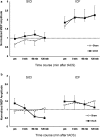The effects of transcranial alternating current stimulation (tACS) at individual alpha peak frequency (iAPF) on motor cortex excitability in young and elderly adults
- PMID: 29943239
- PMCID: PMC6153871
- DOI: 10.1007/s00221-018-5314-3
The effects of transcranial alternating current stimulation (tACS) at individual alpha peak frequency (iAPF) on motor cortex excitability in young and elderly adults
Abstract
Transcranial alternating current stimulation (tACS) can modulate brain oscillations, cortical excitability and behaviour. In aging, the decrease in EEG alpha activity (8-12 Hz) in the parieto-occipital and mu rhythm in the motor cortex are correlated with the decline in cognitive and motor functions, respectively. Increasing alpha activity using tACS might therefore improve cognitive and motor function in the elderly. The present study explored the influence of tACS on cortical excitability in young and old healthy adults. We applied tACS at individual alpha peak frequency for 10 min (1.5 mA) to the left motor cortex. Transcranial magnetic stimulation was used to assess the changes in cortical excitability as measured by motor-evoked potentials at rest, before and after stimulation. TACS increased cortical excitability in both groups. However, our results also suggest that the mechanism behind the effects was different, as we observed an increase and decrease in intracortical inhibition in the old group and young group, respectively. Our results indicate that both groups profited similarly from the stimulation. There was no indication that tACS was more effective in conditions of low alpha power, that is, in the elderly.
Keywords: Aging; Alpha oscillation; Electroencephalogram; Neuronal entrainment; Transcranial alternating current stimulation; Transcranial magnetic stimulation.
Conflict of interest statement
The authors declare that they have no conflict of interest.
Figures




Similar articles
-
Influence of gamma transcranial alternating current stimulation frequency and intensity on motor cortex excitability in young and older adults.J Neurophysiol. 2025 Aug 1;134(2):619-627. doi: 10.1152/jn.00147.2025. Epub 2025 Jul 21. J Neurophysiol. 2025. PMID: 40691054
-
Phase of beta-frequency tACS over primary motor cortex modulates corticospinal excitability.Cortex. 2018 Jun;103:142-152. doi: 10.1016/j.cortex.2018.03.001. Epub 2018 Mar 9. Cortex. 2018. PMID: 29635161
-
μ-Transcranial Alternating Current Stimulation Induces Phasic Entrainment and Plastic Facilitation of Corticospinal Excitability.Eur J Neurosci. 2025 Mar;61(5):e70042. doi: 10.1111/ejn.70042. Eur J Neurosci. 2025. PMID: 40040311 Free PMC article.
-
Effects of beta-tACS on corticospinal excitability: A meta-analysis.Brain Stimul. 2019 Nov-Dec;12(6):1381-1389. doi: 10.1016/j.brs.2019.07.023. Epub 2019 Jul 28. Brain Stimul. 2019. PMID: 31405789
-
The effects of motor cortex rTMS on corticospinal descending activity.Clin Neurophysiol. 2010 Apr;121(4):464-73. doi: 10.1016/j.clinph.2009.11.007. Epub 2010 Jan 21. Clin Neurophysiol. 2010. PMID: 20096628 Review.
Cited by
-
Posttraining Alpha Transcranial Alternating Current Stimulation Impairs Motor Consolidation in Elderly People.Neural Plast. 2019 Jul 24;2019:2689790. doi: 10.1155/2019/2689790. eCollection 2019. Neural Plast. 2019. PMID: 31428143 Free PMC article.
-
Age-Dependent Effect of Transcranial Alternating Current Stimulation on Motor Skill Consolidation.Front Aging Neurosci. 2020 Feb 6;12:25. doi: 10.3389/fnagi.2020.00025. eCollection 2020. Front Aging Neurosci. 2020. PMID: 32116653 Free PMC article.
-
Alpha and beta/low-gamma frequency bands may have distinct neural origin and function during post-stroke walking.Exp Brain Res. 2024 Oct;242(10):2309-2327. doi: 10.1007/s00221-024-06906-8. Epub 2024 Aug 6. Exp Brain Res. 2024. PMID: 39107522
-
DELirium treatment with Transcranial Electrical Stimulation (DELTES): study protocol for a multicentre, randomised, double-blind, sham-controlled trial.BMJ Open. 2024 Nov 2;14(11):e092165. doi: 10.1136/bmjopen-2024-092165. BMJ Open. 2024. PMID: 39488424 Free PMC article.
-
Neuromodulation techniques - From non-invasive brain stimulation to deep brain stimulation.Neurotherapeutics. 2024 Apr;21(3):e00330. doi: 10.1016/j.neurot.2024.e00330. Epub 2024 Feb 9. Neurotherapeutics. 2024. PMID: 38340524 Free PMC article. Review.
References
-
- Awiszus F. Chap. 2 TMS and threshold hunting. In: Paulus WFTMANJGRUZ, Hallett M, editors. Supplements to clinical neurophysiology. Oxfrod: Elsevier; 2003. pp. 13–23. - PubMed
Publication types
MeSH terms
LinkOut - more resources
Full Text Sources
Other Literature Sources
Medical
Molecular Biology Databases
Research Materials

